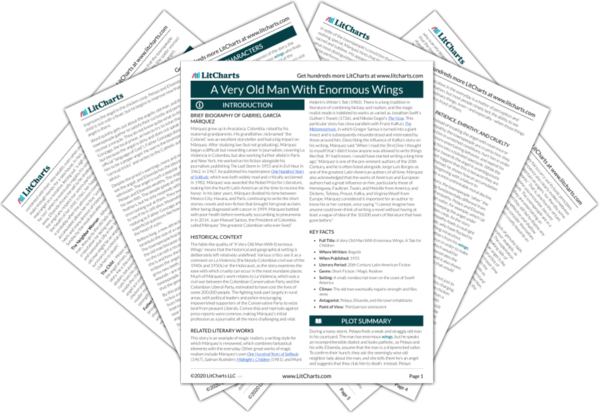When the disheveled old man appears in the mud of Pelayo and Elisenda’s courtyard, he is in the “pitiful condition of a drenched great-grandfather,” and his scraggly “buzzard wings” are the only outward marker that he is anything but a pathetic, rundown man. These wings—which mark him as an angel—symbolize the coexistence of the sacred and the mundane, suggesting that miracles are not wholly out of the ordinary, but are instead inextricable from everyday life. To underscore this point, Márquez describes the angel’s wings as unimpressive: they’re “strewn with parasites” and “dirty and half-plucked.” They seem not to be angelic wings, but rather wings that belong on Earth—the wings of a “sidereal bat” or even, as the doctor suggests, wings that might naturally belong to a human. These wings, and the man to whom they belong, seem so ordinary to the townspeople that they are unable to recognize that the angel’s presence is a miracle, and instead they abuse, exploit, and ignore him, feeling miffed to be cheated out of a proper experience of the supernatural. The ordinary appearance of the clearly-extraordinary wings suggests that miracles are not necessarily obvious or otherworldly; instead, things that are miraculous are all around, and—like the townspeople’s failure to recognize the angel’s significance—it’s only people’s outrageous expectations and inattention that blinds them to the miracles in their everyday lives.
Wings Quotes in A Very Old Man With Enormous Wings
He had to go very close to see that it was an old man, a very old man, lying face down in the mud, who, in spite of his tremendous efforts, couldn’t get up, impeded by his enormous wings.

Unlock explanations and citation info for this and every other A Very Old Man With Enormous Wings quote.
Plus so much more...
Get LitCharts A+He was dressed like a ragpicker. There were only a few faded hairs left on his bald skull and very few teeth in his mouth, and his pitiful condition of a drenched great-grandfather took away any sense of grandeur he might have had. His huge buzzard wings, dirty and half-plucked, were forever entangled in the mud. They looked at him so long and so closely that Pelayo and Elisenda very soon overcame their surprise and in the end found him familiar. Then they dared speak to him, and he answered in an incomprehensible dialect with a strong sailor’s voice. That was how they skipped over the inconvenience of the wings and quite intelligently concluded that he was a lonely castaway from some foreign ship wrecked by the storm.
Father Gonzaga went into the chicken coop and said good morning to him in Latin. The parish priest had his first suspicion of an imposter when he saw that he did not understand the language of God or know how to greet His ministers. Then he noticed that seen close up he was much too human: he had an unbearable smell of the outdoors, the back side of his wings was strewn with parasites and his main feathers had been mistreated by terrestrial winds, and nothing about him measured up to the proud dignity of angels.
The curious came from far away. A traveling carnival arrived with a flying acrobat who buzzed over the crowd several times, but no one paid any attention to him because his wings were not those of an angel but, rather, those of a sidereal bat.
Especially during the first days, when the hens pecked at him, searching for the stellar parasites that proliferated in his wings, and the cripples pulled out feathers to touch their defective parts with, and even the most merciful threw stones at him, trying to get him to rise so they could see him standing. The only time they succeeded in arousing him was when they burned his side with an iron for branding steers, for he had been motionless for so many hours that they thought he was dead. He awoke with a start, ranting in his hermetic language and with tears in his eyes, and he flapped his wings a couple of times, which brought on a whirlwind of chicken dung and lunar dust and a gale of panic that did not seem to be of this world.
The doctor who took care of the child couldn’t resist the temptation to listen to the angel’s heart, and he found so much whistling in the heart and so many sounds in his kidneys that it seemed impossible for him to be alive. What surprised him most, however, was the logic of his wings. They seemed so natural on that completely human organism that he couldn’t understand why other men didn’t have them too.
He remained motionless for several days in the farthest corner of the courtyard, where no one would see him, and at the beginning of December some large, stiff feathers began to grow on his wings, the feathers of a scarecrow, which looked more like another misfortune of decrepitude. But he must have known the reason for those changes, for he was quite careful that no one should notice them, that no one should hear the sea chanteys that he sometimes sang under the stars.
Elisenda let out a sigh of relief, for herself and for him, when she watched him pass over the last houses, holding himself up in some way with the risky flapping of a senile vulture. She kept watching him even when she was through cutting the onions and she kept on watching until it was no longer possible for her to see him, because then he was no longer an annoyance in her life but an imaginary dot on the horizon of the sea.












